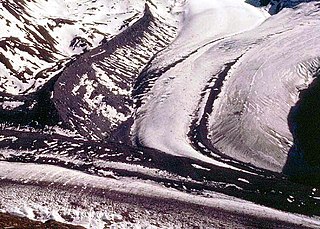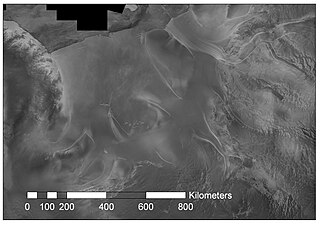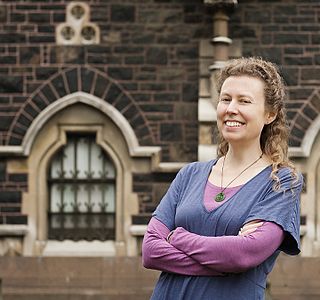Related Research Articles

Glaciology is the scientific study of glaciers, or, more generally, ice and natural phenomena that involve ice.

The Ross Ice Shelf is the largest ice shelf of Antarctica. It is several hundred metres thick. The nearly vertical ice front to the open sea is more than 600 kilometres (370 mi) long, and between 15 and 50 metres high above the water surface. Ninety percent of the floating ice, however, is below the water surface.
The Evans Ice Stream is a large ice stream draining from Ellsworth Land, between Cape Zumberge and Fowler Ice Rise, into the western part of the Ronne Ice Shelf. Mills Glacier flows adjacently into the ice stream from the southwest side. The feature was recorded on February 5, 1974, in Landsat imagery. It was named by the UK Antarctic Place-Names Committee for Stanley Evans, a British physicist who, starting in 1961, developed apparatus for radio echo sounding of icecaps and glaciers from aircraft; he carried out upper atmosphere research at Brunt Ice Shelf, 1956–57.
Radioglaciology is the study of glaciers, ice sheets, ice caps and icy moons using ice penetrating radar. It employs a geophysical method similar to ground-penetrating radar and typically operates at frequencies in the MF, HF, VHF and UHF portions of the radio spectrum. This technique is also commonly referred to as "Ice Penetrating Radar (IPR)" or "Radio Echo Sounding (RES)".
Tavi Murray, FLSW is a glaciologist, the eighth woman to be awarded the Polar Medal.
Engelhardt Ice Ridge is an ice ridge between Whillans Ice Stream and Kamb Ice Stream near the junction of Gould Coast and Siple Coast in Marie Byrd Land, Antarctica. It was named by the Advisory Committee on Antarctic Names after Hermann Engelhardt of the Division of Geological and Planetary Sciences, California Institute of Technology; he was a United States Antarctic Program geophysicist who drilled boreholes in Whillans and Kamb Ice Streams in four field seasons, 1991–96.

John Frederick Nye was a British physicist and glaciologist. He was the first to apply plasticity to understand glacier flow. He was a member of the University of Bristol's physics department for 66 years.

Kamb Ice Stream, a glaciological feature of the Ross Ice Shelf of the West Antarctic Ice Sheet, formerly known as Ice Stream C, the ice stream was renamed in 2001 in honor of Caltech Glaciologist Dr. Barclay Kamb. Its margins were the focus of a sequence of scientific borehole expeditions in 2019 and 2021 where a New Zealand team melted their way through the ice to sample the oceanographic conditions below.
The Echelmeyer Ice Stream, formerly known as Ice Stream F, is a glaciological feature of the West Antarctic Ice Sheet. It is an ice stream flowing west to the Shirase Coast to the north of the MacAyeal Ice Stream, and is one of several major ice streams draining from Marie Byrd Land into the Ross Ice Shelf. The ice streams were investigated and mapped by U.S. Antarctic Research Program personnel in a number of field seasons from 1983–84 and originally named Ice Stream A, B, C, etc., according to their position from south to north.

Rutford Ice Stream is a major Antarctic ice stream, about 290 kilometres (180 mi) long and over 24 kilometres (15 mi) wide, which drains southeastward between the Sentinel Range, Ellsworth Mountains and Fletcher Ice Rise into the southwest part of Ronne Ice Shelf. Named by US-ACAN for geologist Robert Hoxie Rutford, a member of several USARP expeditions to Antarctica; leader of the University of Minnesota Ellsworth Mountains Party, 1963-1964. Rutford served as Director of the Division of Polar Programs, National Science Foundation, 1975-1977.

Mario Giovinetto was an Argentine glaciologist, climatologist and geographer. He was a Canadian citizen with permanent resident status in the United States.

Aster Glacier is an Antarctic glacier descending the east slope of Craddock Massif and flowing between Elfring Peak and Willis Ridge to Thomas Glacier in the Sentinel Range, Ellsworth Mountains in Antarctica. It was named by the Advisory Committee on Antarctic Names in 2006, after Richard Aster, Professor of Geophysics and Department Head of Geosciences at Colorado State University, whose research in Antarctica includes volcanological studies at the Mount Erebus volcano observatory on Ross Island, glaciological, oceanic, and tectonic seismic source studies, seismic tomography, ice shelf studies, and the coupling of solid Earth geophysics and Antarctic ice sheet evolution.

William Stanley Bryce (Stan) Paterson was a leading British glaciologist. He mined glacial cores which then provided climate data for the world's last 100,000 years.

Giles Glacier is a hanging glacier that flows eastward along the south side of Moyher Ridge to Thomas Glacier in the south Sentinel Range in the Ellsworth Mountains. It was named by the Advisory Committee on Antarctic Names in 2006 after J. David Giles, Polar Ice Coring Office, University of Nebraska, who supported United States Antarctic Program drilling operations at Taylor Dome, the South Pole, Windless Bight, Siple Dome and Kamb Ice Stream, from 1993 to 1998.
Johannes Weertman was an American materials scientist and geophysicist.

Christina Hulbe is an American Antarctic researcher, and as of 2016 serves as professor and Dean of Surveying at the University of Otago in New Zealand. She was previously Chair of the Geology Department at Portland State University in Portland, Oregon. She leads the NZARI project to drill through the Ross Ice Shelf and is the namesake of the Hulbe glacier.

Julie Michelle Palais is an American polar glaciologist who has made significant contributions to climate change research studying volcanic fallout in ice cores from both Greenland and Antarctica. For many years, starting in 1990, she played a pivotal role working at the National Science Foundation (NSF) as Program Director of the Antarctic Glaciology Program in the Division of Polar Programs, including many trips to both North and South Polar regions. Both the Palais Glacier and Palais Bluff in Antarctica were named in her honor and she has received many further recognitions for her distinguished career.

Frank Jean-Marie Léon Pattyn is a Belgian glaciologist and professor at the Université libre de Bruxelles. He is best known for developing ice-sheet models and leading model intercomparisons.
Martin J. Siegert is a British glaciologist, and Deputy Vice Chancellor (Cornwall) at the University of Exeter. He co-Chairs the Diversity in Polar Science Initiative, and has spoken about socio-economic inclusion in Polar Science and indeed broader society.

Guðfinna 'Tollý' Aðalgeirsdóttir is professor in Geophysics at the Faculty of Earth Sciences, University of Iceland.
References
- ↑ List of members of the National Academy of Sciences (Geology). List
- 1 2 Division of Geological and Planetary Sciences. Barclay Profile
- ↑ "W. Kamb Obituary (2011) - San Gabriel, CA - San Gabriel Valley Tribune". Legacy.com .
- ↑ "Barcley Kamb 1928-2011". International Glaciological Society (IGS). April 21, 2011.
- ↑ "The Month At Caltech." Engineering and Science March 1972: 1.
- ↑ "W. Barclay Kamb". John Simon Guggenheim Memorial Foundation.
- 1 2 Kamb, Barclay. "Glacier Mechanics." 21 September 2004. Geological Planetary Sciences.
- ↑ "W. Barclay Kamb, 79". Caltech News Kamb Obituary.
- ↑ Tindol, Robert. "Antarctic Landmarks Named After Caltech Experts On Glacier Ice Flow." Caltech Press (2003)